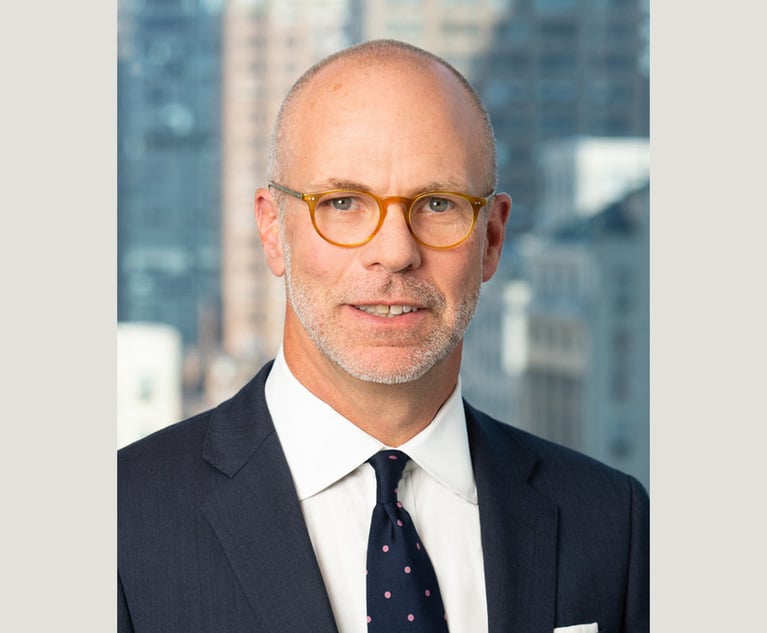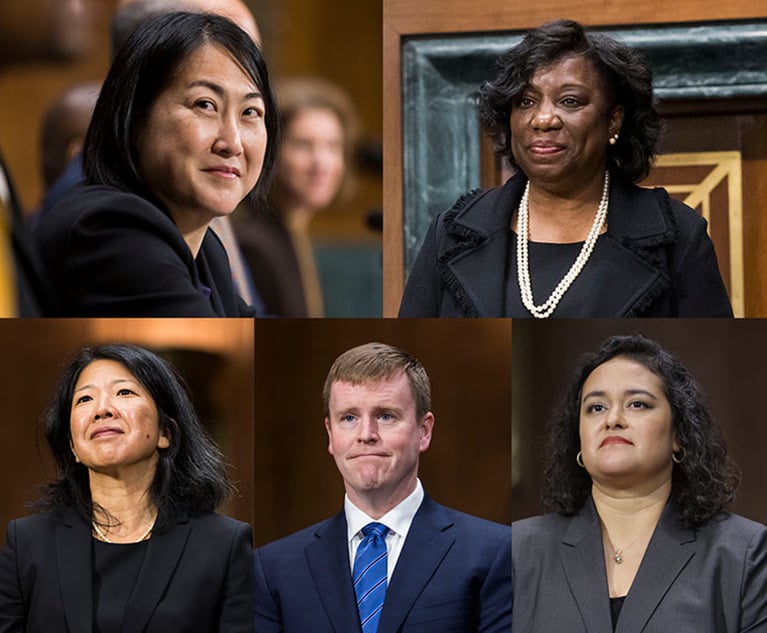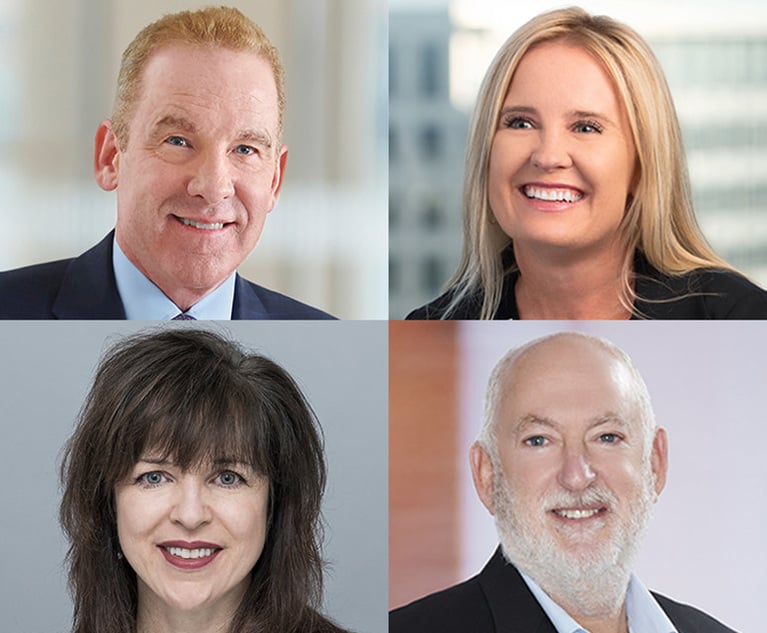Litigator of the Week: A $1.74B Payout in a Monster of a Case
Representing Lehman Brothers and its creditors committee, Quinn Emanuel Urquhart & Sullivan partner Andrew Rossman led a team in securing a $1.74 billion settlement from Citigroup.
October 07, 2017 at 06:15 PM
16 minute read

They called it “a tale of two Citis.”
Representing Lehman Brothers and its creditors committee, Quinn Emanuel Urquhart & Sullivan partner Andrew Rossman led a team in securing a $1.74 billion settlement from Citigroup on Sept. 29.
It was a massive effort. The opening arguments in In Re: Lehman Brothers Holdings, the remnants of the collapsed financial firm's attempts to claw back derivatives stakes from Citigroup, spoke to the awesome magnitude of the undertaking.
“Your opening is usually an hour or something like that,” Rossman said. “We were at the podium the whole day.”
After four months of trial, the parties agreed to settle. The reasoning behind the terms is opaque; Rossman himself said he couldn't discuss much of what went into it. But what's clear is that it's a significant win for Rossman's team and his clients in the largest derivatives suit to go to trial.
The conflict stems from a $2 billion cash deposit that Lehman made with Citibank on June 12, 2008. The firm filed for bankruptcy three months later. Citi claimed it was entitled to keep the money.
The parties talked on and off throughout the trial, he said, at both the business level as well as between attorneys. The court-led mediation came after a summer recess in the case. After intensive, almost round-the-clock discussions over five days, a resolution was reached.
“By the time we had four months of trial, I think everybody had a pretty good idea as to what the case was shaping up to be,” Rossman said.
The process began with how Rossman and his team organized the trial itself. There were 30 expert witnesses and thousands of pages of expert reports, he said. A million-plus trade database had to be crunched. Some 150 depositions had to be taken. And there were millions of pages of documents to get through.
“In terms of cases going to trial, this is the longest and most complex case I've ever seen by an order of magnitude,” he said. “The sheer size of this thing was like nothing you can compare it to.”
For Rossman's team, the name of the game was simplicity: how to bring something so big and so complex down to something manageably comprehensible—not just for themselves, but also for U.S. Bankruptcy Judge Shelley Chapman of the Southern District of New York.
“It took a lot of work to put this together in the opening, but I said we're going to help the judge understand how an entire bank's derivative trading works starting with one bet on a Mets-Yankees baseball game,” Rossman said.
Making the information accessible was only one piece of the puzzle. Rossman and his team also worked hard to make sure it was being presented in a way that made sense. To do so, the trial would operate as a series of mini-trials, Rossman said.
The 30,000-plus trades at issue were broken down by product areas, and even sub-product areas. The single biggest piece of the $2 billion dispute was Lehman's credit-trading business. That's where they started, focusing first on flow credit issues, and then descending into further discrete areas within the overall topic as needed.
Rather than have each side present its case in succession, witnesses were juxtaposed. That is, Citi's fact witnesses would go first, then its particular product-area expert, followed by Lehman's own experts, “so the judge could see the dueling experts side-by-side,” Rossman said.
As the trial proceeded, Rossman and his team hammered home the theme of “two Citis.”
“The idea was, here's how Citi runs its business every day, versus here's how Citi priced its claim in the bankruptcy court against Lehman, and how different they were, trying to use Citi's own regular-court practices as the right barometer for determining what they should have done,” he said. “We were always trying to come back to that very simple theme to make it understandable.”
After four months, they “finished just past the halfway mark,” said Rossman.
Since 2008, Rossman has steered all of Lehman's big bank litigation. The Citi settlement resolves the disputes with 12 of 13 banks. Only Credit Suisse remains unsettled.
Rossman said his clients have retained the same posture throughout the process.
“Lehman's always available to talk to people,” he said.

They called it “a tale of two Citis.”
Representing Lehman Brothers and its creditors committee,
It was a massive effort. The opening arguments in In Re: Lehman Brothers Holdings, the remnants of the collapsed financial firm's attempts to claw back derivatives stakes from
“Your opening is usually an hour or something like that,” Rossman said. “We were at the podium the whole day.”
After four months of trial, the parties agreed to settle. The reasoning behind the terms is opaque; Rossman himself said he couldn't discuss much of what went into it. But what's clear is that it's a significant win for Rossman's team and his clients in the largest derivatives suit to go to trial.
The conflict stems from a $2 billion cash deposit that Lehman made with Citibank on June 12, 2008. The firm filed for bankruptcy three months later. Citi claimed it was entitled to keep the money.
The parties talked on and off throughout the trial, he said, at both the business level as well as between attorneys. The court-led mediation came after a summer recess in the case. After intensive, almost round-the-clock discussions over five days, a resolution was reached.
“By the time we had four months of trial, I think everybody had a pretty good idea as to what the case was shaping up to be,” Rossman said.
The process began with how Rossman and his team organized the trial itself. There were 30 expert witnesses and thousands of pages of expert reports, he said. A million-plus trade database had to be crunched. Some 150 depositions had to be taken. And there were millions of pages of documents to get through.
“In terms of cases going to trial, this is the longest and most complex case I've ever seen by an order of magnitude,” he said. “The sheer size of this thing was like nothing you can compare it to.”
For Rossman's team, the name of the game was simplicity: how to bring something so big and so complex down to something manageably comprehensible—not just for themselves, but also for U.S. Bankruptcy Judge Shelley Chapman of the Southern District of
“It took a lot of work to put this together in the opening, but I said we're going to help the judge understand how an entire bank's derivative trading works starting with one bet on a Mets-Yankees baseball game,” Rossman said.
Making the information accessible was only one piece of the puzzle. Rossman and his team also worked hard to make sure it was being presented in a way that made sense. To do so, the trial would operate as a series of mini-trials, Rossman said.
The 30,000-plus trades at issue were broken down by product areas, and even sub-product areas. The single biggest piece of the $2 billion dispute was Lehman's credit-trading business. That's where they started, focusing first on flow credit issues, and then descending into further discrete areas within the overall topic as needed.
Rather than have each side present its case in succession, witnesses were juxtaposed. That is, Citi's fact witnesses would go first, then its particular product-area expert, followed by Lehman's own experts, “so the judge could see the dueling experts side-by-side,” Rossman said.
As the trial proceeded, Rossman and his team hammered home the theme of “two Citis.”
“The idea was, here's how Citi runs its business every day, versus here's how Citi priced its claim in the bankruptcy court against Lehman, and how different they were, trying to use Citi's own regular-court practices as the right barometer for determining what they should have done,” he said. “We were always trying to come back to that very simple theme to make it understandable.”
After four months, they “finished just past the halfway mark,” said Rossman.
Since 2008, Rossman has steered all of Lehman's big bank litigation. The Citi settlement resolves the disputes with 12 of 13 banks. Only Credit Suisse remains unsettled.
Rossman said his clients have retained the same posture throughout the process.
“Lehman's always available to talk to people,” he said.
This content has been archived. It is available through our partners, LexisNexis® and Bloomberg Law.
To view this content, please continue to their sites.
Not a Lexis Subscriber?
Subscribe Now
Not a Bloomberg Law Subscriber?
Subscribe Now
NOT FOR REPRINT
© 2025 ALM Global, LLC, All Rights Reserved. Request academic re-use from www.copyright.com. All other uses, submit a request to [email protected]. For more information visit Asset & Logo Licensing.
You Might Like
View All
2024 Marked Growth On Top of Growth for Law Firm Litigation Practices. Is a Cooldown in the Offing for 2025?

Big Company Insiders See Technology-Related Disputes Teed Up for 2025

Tips From—and About—the New Judges on the Northern District of California Bench
Trending Stories
- 1'Not the President's Personal Lawyer': Lawyers Share Concerns Over How AG Pick Bondi’s Loyalism to Trump May Impact DOJ
- 2US Judge OKs Partial Release of Ex-Special Counsel's Final Report in Election Case
- 3The Demise of Truth and Transparency in Federal Sentencing
- 4Former Phila. Solicitor Sozi Tulante Rejoins Dechert
- 5'I've Seen Terrible Things': Lawyer Predicts Spike in Hazing Suits
Who Got The Work
Michael G. Bongiorno, Andrew Scott Dulberg and Elizabeth E. Driscoll from Wilmer Cutler Pickering Hale and Dorr have stepped in to represent Symbotic Inc., an A.I.-enabled technology platform that focuses on increasing supply chain efficiency, and other defendants in a pending shareholder derivative lawsuit. The case, filed Oct. 2 in Massachusetts District Court by the Brown Law Firm on behalf of Stephen Austen, accuses certain officers and directors of misleading investors in regard to Symbotic's potential for margin growth by failing to disclose that the company was not equipped to timely deploy its systems or manage expenses through project delays. The case, assigned to U.S. District Judge Nathaniel M. Gorton, is 1:24-cv-12522, Austen v. Cohen et al.
Who Got The Work
Edmund Polubinski and Marie Killmond of Davis Polk & Wardwell have entered appearances for data platform software development company MongoDB and other defendants in a pending shareholder derivative lawsuit. The action, filed Oct. 7 in New York Southern District Court by the Brown Law Firm, accuses the company's directors and/or officers of falsely expressing confidence in the company’s restructuring of its sales incentive plan and downplaying the severity of decreases in its upfront commitments. The case is 1:24-cv-07594, Roy v. Ittycheria et al.
Who Got The Work
Amy O. Bruchs and Kurt F. Ellison of Michael Best & Friedrich have entered appearances for Epic Systems Corp. in a pending employment discrimination lawsuit. The suit was filed Sept. 7 in Wisconsin Western District Court by Levine Eisberner LLC and Siri & Glimstad on behalf of a project manager who claims that he was wrongfully terminated after applying for a religious exemption to the defendant's COVID-19 vaccine mandate. The case, assigned to U.S. Magistrate Judge Anita Marie Boor, is 3:24-cv-00630, Secker, Nathan v. Epic Systems Corporation.
Who Got The Work
David X. Sullivan, Thomas J. Finn and Gregory A. Hall from McCarter & English have entered appearances for Sunrun Installation Services in a pending civil rights lawsuit. The complaint was filed Sept. 4 in Connecticut District Court by attorney Robert M. Berke on behalf of former employee George Edward Steins, who was arrested and charged with employing an unregistered home improvement salesperson. The complaint alleges that had Sunrun informed the Connecticut Department of Consumer Protection that the plaintiff's employment had ended in 2017 and that he no longer held Sunrun's home improvement contractor license, he would not have been hit with charges, which were dismissed in May 2024. The case, assigned to U.S. District Judge Jeffrey A. Meyer, is 3:24-cv-01423, Steins v. Sunrun, Inc. et al.
Who Got The Work
Greenberg Traurig shareholder Joshua L. Raskin has entered an appearance for boohoo.com UK Ltd. in a pending patent infringement lawsuit. The suit, filed Sept. 3 in Texas Eastern District Court by Rozier Hardt McDonough on behalf of Alto Dynamics, asserts five patents related to an online shopping platform. The case, assigned to U.S. District Judge Rodney Gilstrap, is 2:24-cv-00719, Alto Dynamics, LLC v. boohoo.com UK Limited.
Featured Firms
Law Offices of Gary Martin Hays & Associates, P.C.
(470) 294-1674
Law Offices of Mark E. Salomone
(857) 444-6468
Smith & Hassler
(713) 739-1250







